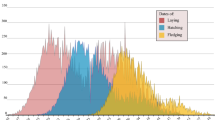Summary
Ospreys (Pandion haliaetus) were observed for 350 h in 1975 in southeastern Virginia. Other studies have demonstrated that weather can have an effect on aspects of osprey foraging behavior (e.g., frequency of diving), but for the environmental conditions observed in this study, weather and other variables did not appear to limit the ability of ospreys to feed their young.
Male ospreys, which procure essentially all of the food for the family unit before the chicks fledge, spend an average of 43% of the daylight hours perched near the nest when they have unfledged young. About 1/3 of the daylight hours are utilized for hunting. Weather conditions have no effect on the time the male his perched near the nest, or on the rate of fish delivery by the male. Wind speed variability regressed positively with the time it took males to return with a fish (mean time=0.64 h/fish), but accounted for only 16% of the variation in the length of hunting trips. Size of fish delivered and rate of fish delivery were unrelated to either brood size or age of young. As the chicks age, the male spends increasing amounts of time away from the nest; this is not related to changes in weather, and appears to be due to decreasing attentiveness at the nest site by the male. Females with unfledged young spent over 95% of the daylight hours at the nest.
Adults with fledged but dependent young spend an average of 1/3 of the day perched near the nest. Both adults deliver fish at this time, but together they bring no more than the male alone brought before fledging. For both adults neither the percentage of time perched near the nest nor the rate of fish delivery are related to weather conditions.
Similar content being viewed by others
References
Barr, A.J., Goodnight, J.H.: A user's guide to the statistical analysis system. Raleigh, N.C.: North Carolina State University 1972
Beebe, F.L.: Field studies of the Falconiformes of British Columbia. Victoria, B.C., Occasional Papers of the British Columbia Provincial Museum No. 17 (1974)
Donn, W.L.: The earth: Our physical environment. New York: Wiley 1972
Draper, N.R., Smith, H.: Applied regression analysis. New York: Wiley 1967
Dunn, E.K.: Changes in fishing ability of terns associated with windspeed and sea surface conditions. Nature 244, 520–521 (1973)
Dunn, E.K.: The role of environmental factors in the growth of tern chicks. J. Anim. Ecol. 44, 743–754 (1975)
Finlay, J.C.: Some effects of weather on Purple Martin activity. Auk 93, 231–244 (1976)
Green, R.: Breeding behaviour of Ospreys Pandion haliaetus in Scotland. Ibis 118, 475–490 (1976)
Grubb, T.C., Jr.: Weather-dependent foraging in Ospreys. Auk 94, 146–149 (1977)
LeCren, E.D.: The length-weight relationship and seasonal cycle in gonad weight and condition in the perch (Perca fluviatius). J. Anim. Ecol. 20, 201–219 (1951)
Markle, D.F.: The seasonality of availability and movements of fishes in the channel of the York River, Virginia. Chesapeake Sci. 17, 50–55 (1976)
Nie, N.H., Hull, C.H., Jenkins, J.G., Steinbrenner, K., Bent, D.H.: SPSS Statistical package for the social sciences. 2nd ed. New York: McGraw-Hill 1975
Snyder, N.F.R., Snyder, H. A.: Experimental study of feeding rates of nesting Cooper's hawks. Condor 75, 461–463 (1973)
Stinson, C.H.: The evolutionary and ecological significance of the clutch size of the osprey (Pandion haliaetus. Williamsburg, Va., M.A. thesis, College of William and Mary (1976)
Stinson, C.H.: Familial longevity in Ospreys. Bird-Banding 48, 72–73 (1977a)
Stinson, C.H.: Growth and behaviour of young ospreys Pandion haliaetus. Oikos 28, 299–303 (1977b)
Ueoka, M.L.: Feeding behavior of ospreys at Humboldt Lake, California. Arcata, Ca., M.S. thesis, Humboldt State College (1974)
Ueoka, M.L., Koplin, J.R.: Foraging behavior of Ospreys in northwestern California. Raptor Res. 7, 32–38 (1973)
U.S. Department of Commerce: Tide Tables, High and Low Water Predictions, 1975, East Coast of North and South America including Greenland. Washington, D.C.: U.S. Government Printing Office 1975
Waterston, G.: Notes on the breeding biology of the Speyside Ospreys—1959 and 1960. Bird Notes 29, 130–135 and 174–184 (1961)
Author information
Authors and Affiliations
Rights and permissions
About this article
Cite this article
Stinson, C.H. The influence of environmental conditions on aspects of the time budgests of breeding ospreys. Oecologia 36, 127–139 (1978). https://doi.org/10.1007/BF00349803
Received:
Issue Date:
DOI: https://doi.org/10.1007/BF00349803




